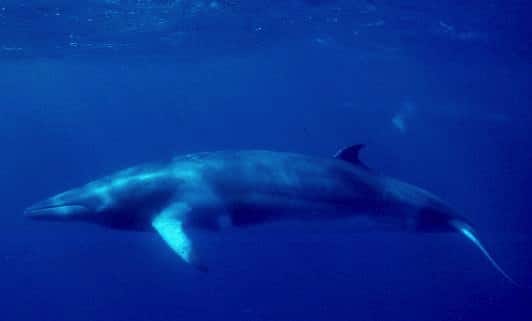Narwhal Whale – Monodon monoceros
Description
One type of toothed whale is the Narwhal Whale. It fits in about the mid range when it comes to sizes of whales. One of their distinct characteristics for the males is a tusk that is very long and straight along the jaw. Many people wonder what it is for, and assume it is for fighting. Yet whales have no enemies but man so that isn’t the case. Researchers believe it has to do with a type of sexual attraction for females.
Mature males are up to 3,500 pounds with females much smaller at 1,800 pounds. They are black and white when they are young but by the time they are mature they will be completely white in color with some patches.
Behavior
You may be surprised when you learn how deep the Narwhale Whale can dive. This is to help regulate the body temperature as the water will be warmer where it is deeper. They can spend a great deal of time underneath thick sheets of ice too before they have to find a crack in it for air or come completely to the surface. They can dive from 2,600 feet to 4,900 feet.
These are very social mammals too as they gather in large groups. There is generally from 10 to 15 of Narwhal Whales in a clan. When there are several males, they may rub tusks with each other in a manner. It is believed that this is a contest that allows them to determine the hierarchy of the clan.
While the Narwhal does migrate seasonally, they have a very short distance that they follow. This is believed to be due to the specific foods that they consume. They are more precise about what they consume than most other forms of whales out there.
Diet/Feeding
This particular type of whale has a very specialized diet. This is one of the reasons why it doesn’t migrate. Some of the most popular foods that they consume include cod, halibut, squid, and shrimp.
The diet for a Narwhal whale will depend on what time of year it happens to be. In the winter months they will consume what are known as flatfish under the layers of ice. One of the biggest threats out there to this particular type of whale is global warming. As the layers of ice in this area melt there is less of a food selection. Climate changes can make it hard for them to find enough food to survive on at times.
Distribution
You will mainly find the Narwhal Whale out there around the Artic areas. They have been found to reside around Canada and Russia. The most recent count is approximately 75,000 of them.
Reproduction
Very little is actually known about the reproduction process for the Narwhal Whale. This is due to the time of year when they do it and the limited access available to humans in such remote areas. It is believed that the gestation period is from 10 to 16 months in length. It is also believed that the young only nurse from 4 to 6 months rather than the first year of life which is standard for whales.
Human Interaction
People love to hunt the Narwhal and have done so for thousands of years. The meat from it is said to be among the best when it comes to whales. Therefore such meat can be sold for a higher price than other types of it. The ivory found on it has also lead to it being one that is often involved in Whaling activities.
However, they have been able to continue high enough numbers that they aren’t in danger of becoming extinct at this time. Very few of them are ever found in captivity. This is because the mortality rate is extremely high. All most all of them have died within a couple of months. It is believed this is due to various types of bacteria that such an environment exposes them to.







